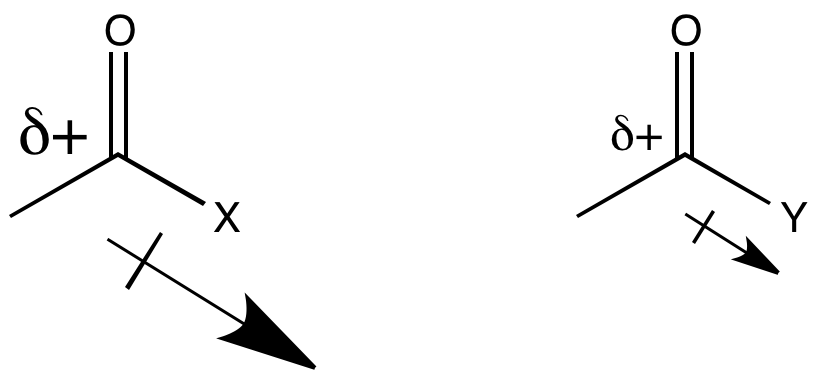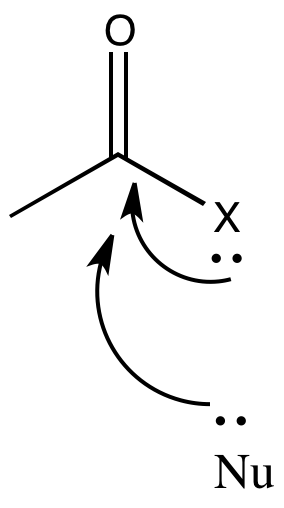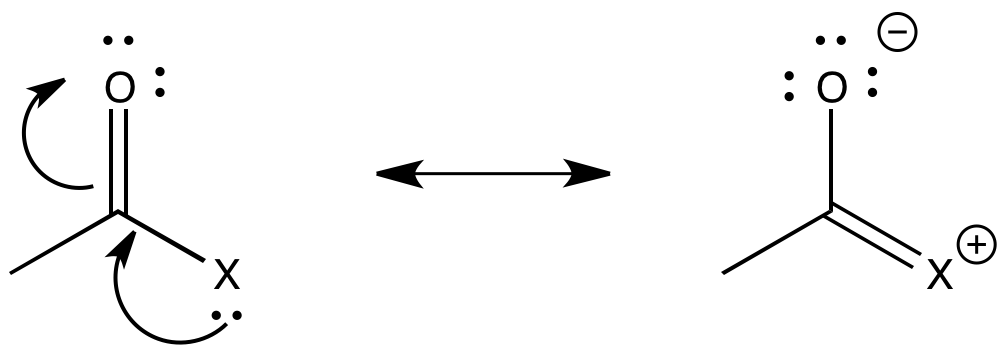
Figure CX3.1. A potential energy curve showing relative reactivity of carboxyloids.
Reactivity in Chemistry
Substitution at Carboxyloids
CX3. Comparative Energies: The Ski Hill
In most cases, the reactivity of carboxyloids involves converting one carboxyloid into another. This is done by replacing one heteroatom substituent with another. For example, the chloride in an acid chloride may be replaced by an alcohol or alkoxide ion to make an ester.
The fact that one carboxyloid can be converted into another suggests that there would be an equilibrium between them. The ratio of two carboxyloids at equilibrium would be determined by their relative stability, as well as the stability of other associated species in solution.
We can map out the stability of carboxyloids on a potential energy surface, as shown below. The higher energy, less stable, more reactive carboxyloids are shown at the top of the potential energy curve. The lower energy, more stable, less reactive carboxyloids are found lower down on the potential energy curve.
Figure CX3.1. A potential energy curve showing relative reactivity of carboxyloids.
The heteroatom attached to the carbonyl in a carboxyloid is always an electronegative atom with a lone pair. Either of those two features might be useful in understanding the reactivity trend illustrated above. For example, an electronegative atom would make the carbonyl carbon more positive. That carbon is already very positive because of the double bond to oxygen. Adding an additional electronegative atom should make it even more so. The amount of positive charge on the carbonyl carbon would be even greater if the atom attached to it were exceptionally electronegative.

Figure CX3.2. Dipole in the carbonyl-heteroatom bond.
On the other hand, a nearby lone pair might counteract the electron-attracting power of the carbonyl carbon. In a sense, we might think about that lone pair as competing with donation from a potential nucleophile.

Figure CX3.3. π-donation in the carbonyl-heteroatom bond.
The ability of an atom to π-donate, then, might have an influence on how strongly the carbonyl will attract nucleophiles. Of course, there is some trade-off involved in π-donation. Usually the atom that donates must take on a positive charge, since it is lending a pair of its own electrons to another atom. Factors that influence how easily this may happen could be important in determining carboxyloid reactivity.

Figure CX3.4. Resonance in carboxyloids.
Problem CX3.1.
Based on electronegativity of the atom attached to the carbonyl carbon, we might expect a specific trend in carboxyloid reactivity. Explain how this factor would affect electrophilicity at the carbonyl carbon and predict the corresponding trend in reactivity. Compare this trend with the information in Figure CX3.1.
Problem CX3.2.
Lone pair donation from the atom attached to the carbonyl carbon could also influence carboxyloid reactivity. Explain how this factor would affect electrophilicity at the carbonyl carbon and predict the corresponding trend in reactivity. Compare this trend with the information in Figure CX3.1.
Problem CX3.3.
Using the information in Figure CX3.1, explain why peptides (containing a number of amide bonds, R(C=O)N) are such a common structural feature in biology.
The potential energy curve in Figure CX3.1 is a useful index for the interconversion of carboxyloids. In general, it is easy to go downhill on the curve, but more difficult to go uphill. That means that compounds lower down on the ski hill can be made easily from compounds farther up the ski hill.
In general, pi donation from the heteroatom attached to the carbonyl is a primary factor that determines carboxyloid reactivity. The more able the heteroatom is to donate its pi electrons, the less electrophilic is the carbonyl. Nitrogen is very good at donating its lone pair. It is about the same size as the carbon atom it needs to donate to, and it only a little more electronegative than the carbon.
Oxygen (in esters and carboxylic acids) is next in line, since oxygen is more electronegative than nitrogen.
Chlorine and sulfur are a little too large to donate very well to a carbon atom. The size and energy mismatch between these atoms leads to poor pi bonding, and poor pi donation.

Figure CX3.4. Size of π-orbitals in carboxyloids.
There is an additional relationship found in the carboxyloid ski hill. In addition to showing us about the influence of π-donation, we also see the stability of possible leaving groups. Not only are the compounds at the top of the hill the most reactive electrophiles, but after substitution they also leave behind the most stable leaving groups. Leaving group stability, and anion stability in general, is closely related to acid-base principles. Anions can be stabilized if the negative charge is located on an electronegative atom, such as oxygen or nitrogen. However, the anion becomes even more stable if the negative charge is delocalized by resonance, or the negatively charged atom is polarizable.

Figure CX3.5. Leaving group ability of carboxyloid substituents.
Thus, anions such as chloride and thiolates are very stable because of polarizability, and so are carboxylates because of resonance delocalization. That means that, in any substitution reaction happening at equilibrium, acid chlorides, thioesters and carboxylates are not likely to re-form. Those three kinds of carboxyloids are much more likely to react to make other kinds of derivatives, such as amides and esters.
Problem CX3.4.
Place the following compounds in their relative positions on the ski hill.

Problem CX3.5.
Oxalyl chloride (left) and thionyl chloride (right) are even higher on the ski hill than regular acid chlorides. Propose a reason that explains this relative instability as electrophiles.

Answers to selected problems are found here.
This site was written by Chris P. Schaller, Ph.D., College of Saint Benedict / Saint John's University (retired) with other authors as noted on individual pages. It is freely available for educational use.

Structure & Reactivity in Organic, Biological and
Inorganic Chemistry by
Chris Schaller is licensed under a
Creative
Commons Attribution-NonCommercial 3.0 Unported License.
Send corrections to cschaller@csbsju.edu
This material is based upon work supported by the National Science Foundation under Grant No. 1043566.
Any opinions, findings, and conclusions or recommendations expressed in this material are those of the author(s) and do not necessarily reflect the views of the National Science Foundation.
Navigation:
Back to Carboxyl Substitution Index
Back to Web Materials on Structure & Reactivity in Chemistry